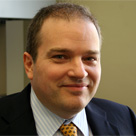About Circuit Design Research at C2S2
FCRP Legacy Content
FCRP Phase V ended on 31-Jan-2013, and this content may no longer be current.
Longer term microelectronics research is now being sponsored by DARPA and industry participants in STARnet (FCRP Phase VI).
Overview
 Lawrence Pileggi, Center Director
Lawrence Pileggi, Center Director The collaborative multi-university Center for Circuit & System Solutions (C2S2) addresses "circuits & modules" design challenges that threaten us at the end of CMOS scaling that represent new opportunities in the functionally diverse "More than Moore" arena, and that are required to make post-Si circuits viable.The science of integrated circuit and module design is the conversion of transistors into useful performance, delivered in useful form factors (i.e., modules), operating under stringent power limits, for integration in diverse systems. Looking backwards, we see three decades of investment in semiconductors, circuits, and design methods that have resulted in phenomenal progress. Looking forward we are focused on five prominent challenges that represent the Center's mission:
The collaborative multi-university Center for Circuit & System Solutions (C2S2) addresses "circuits & modules" design challenges that threaten us at the end of CMOS scaling that represent new opportunities in the functionally diverse "More than Moore" arena, and that are required to make post-Si circuits viable.The science of integrated circuit and module design is the conversion of transistors into useful performance, delivered in useful form factors (i.e., modules), operating under stringent power limits, for integration in diverse systems. Looking backwards, we see three decades of investment in semiconductors, circuits, and design methods that have resulted in phenomenal progress. Looking forward we are focused on five prominent challenges that represent the Center's mission:
The end of the CMOS roadmap is near: End-of-the-roadmap devices challenge us with difficult physics, unreliability, statistical extremes, cost-of-design and cost-of-fab. Yet they entice us with opportunities for improved density, performance and raw computing power. Good circuit design should hide the difficult behaviors of devices from the system builders, while exploiting those behaviors that yield useful performance. Today's circuit/module design strategies will not be able to hide or exploit all of the adversarial behaviors we anticipate at the end of the CMOS roadmap. We are inventing the new circuit and module design strategies that are needed to enable scaling to the end of the roadmap.
Maximum performance is unexploitable because customization is unaffordable: Today, we leave significant performance unexploited when we retreat to simpler, unspecialized hardware solutions due to the complexity, risk and cost of integrated circuit design. This is increasingly harmful in both the commercial and defense arenas; there are killer products we are not selling and vital defense applications we are not fielding because we cannot affordably harness the power of the all the transistors we could be building. We are developing strategies and productivity tools to deliver a range of customized solutions, across all applications, at all volumes.
Opportunities beyond Information Technology (IT) applications are exploding: Moore's Law fueled the IT revolution of the last 40 years; we must work to maximize its longevity. But we cannot ignore the explosion of novel applications for new semiconductor-based solutions. This "More-than-Moore" space is a huge opportunity for both volume-sensitive commercial applications (e.g., health) and capability-sensitive defense applications (e.g., warfighter communications). We are exploring a range of functionally diverse applications to understand the constraints and scope of this opportunity.
Design strategies for nondigital circuits/modules are unsystematic: Today we barely handle the design challenges of large digital systems. We badly handle the challenges of nondigital components on those systems, especially those that incorporate heterogeneous technologies. Attempts to target More-than-Moore applications, or extreme-capability defense systems, are limited by these problems. We cannot continue to do these designs in this unstructured, ad hoc fashion. We are working to formally restructure both the fundamental circuits and design methods in the nondigital domain that will dramatically improve productivity, risk, and cost.
Post-silicon circuits are (almost) real: Although we lack a consensus post-CMOS device, we have no lack of contenders. But to truly evaluate the merits of these candidate devices, we must deploy them in circuits and measure the results. We must form close partnerships between device and circuit designers, with clear intent to demonstrate working circuits. We are developing modules and methods to actively assist post-silicon devices to "cross the chasm" from promising physics to practical circuits and modules.
Research Focus
The Center will invent the radical new circuit/module concepts needed to convert novel devices into robust performance across a wide range of commercial and defense applications. We are targeting end-of-roadmap silicon, diverse More-than-Moore technologies, and promising post-Si devices. We are targeting both digital and nondigital circuits and modules. We are further investing in circuit-oriented tools/flows to dramatically improve design productivity for tomorrow's largest digital modules/systems, and to incorporate structure into the nondigital design process so that it can remain affordable.
To achieve these research objectives, the Center is organized into the following themes:
- Circuits/Modules Infrastructure
- Enterprise Systems
- Portable Electronics
- Functional Diversity
- Emerging Circuits


